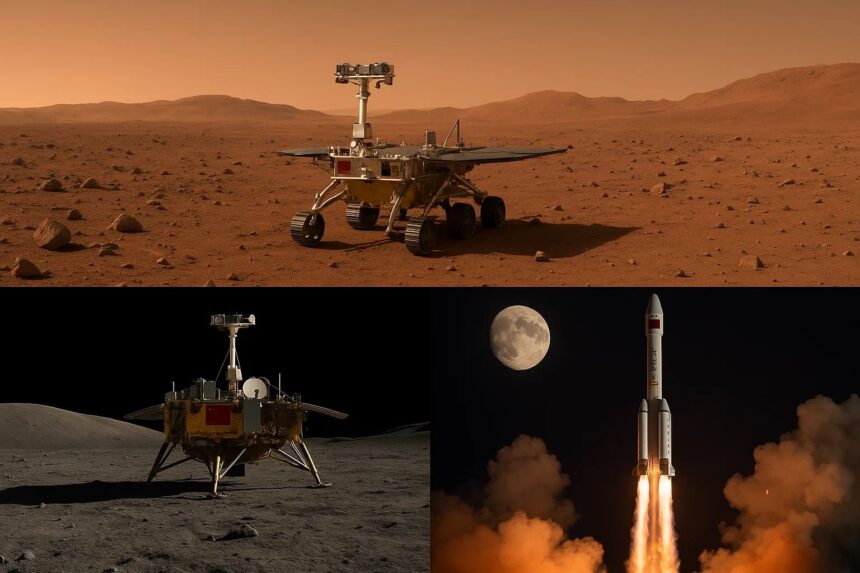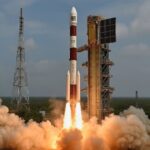China Advances Space Ambitions with Mars, Moon Milestones
Beijing, August 10, 2025 – As the global space race intensifies, China is accelerating its extraterrestrial pursuits, achieving groundbreaking milestones in lunar and Martian exploration while laying the groundwork for crewed missions and international collaborations. From retrieving samples from the Moon’s far side to launching ambitious asteroid-sampling probes en route to Mars-related technologies, China’s space program is not only expanding its technical prowess but also challenging established players like the United States in the quest for space dominance.
Historical Context: From Missiles to Deep Space
China’s space journey began in the 1950s amid Cold War tensions, initially focused on missile technology with Soviet assistance. The program gained independence after the Sino-Soviet split in the early 1960s, leading to the launch of China’s first satellite, Dong Fang Hong 1, in 1970, making it the fifth nation to achieve orbital capability. Managed by the China National Space Administration (CNSA) and the People’s Liberation Army Strategic Support Force, the program evolved from defense-oriented rockets to ambitious deep space endeavors.
The Chinese Lunar Exploration Program (CLEP), approved in 2004, structured lunar efforts into three phases: orbiting, landing, and returning samples. Mars exploration followed suit, with the Planetary Exploration of China program announced in 2020, targeting planets, asteroids, and beyond. These initiatives have positioned China as a formidable force, with over 60 launches planned annually and a focus on self-reliance in technology.
Lunar Milestones: Paving the Way for Human Footprints
China’s lunar achievements have been particularly prolific, culminating in recent tests that edge the nation closer to a crewed Moon landing. On August 7, 2025, China successfully tested its Lanyue lunar lander—meaning “embrace the moon”—at a simulated lunar site in Hebei province. The test verified the lander’s ascent and descent systems under multiple conditions, including a surface mimicking lunar soil reflectivity, rocks, and craters. This marks a critical milestone in the manned lunar program, with the Lanyue designed to ferry astronauts from orbit to the surface, serving as a habitat, power source, and data center post-landing.
Building on past successes, the Chang’e-6 mission, launched in May 2024, achieved the world’s first sample return from the Moon’s far side, landing in the Apollo Basin on June 1, 2024, and returning 1,731 grams of samples to Earth on June 25, 2024. This followed Chang’e-5’s 2020 near-side sample return and Chang’e-4’s historic 2019 far-side landing with the Yutu-2 rover. In April 2025, China announced sharing these lunar samples with international researchers, fostering collaborations with entities from Pakistan to Thailand and even NASA-funded institutions.
These feats underscore China’s rapid progress. Earlier milestones include Chang’e-1’s 2007 orbital mapping and Chang’e-3’s 2013 soft landing with the Yutu rover, making China the third nation to achieve a lunar soft landing. In June 2025, the next-generation Mengzhou crew capsule aced a pad abort test, complementing the development of the Long March 10 rocket for crewed orbital and lunar missions.
Mars Advances: From Rovers to Sample Returns
On the red planet, China’s ambitions are equally bold. The Tianwen-1 mission, launched in 2020, marked China’s first successful Mars endeavor, with the Zhurong rover landing in Utopia Planitia in May 2021—the second nation after the U.S. to operate a rover on Mars. By 2025, this foundation has propelled further missions.
In May 2025, Tianwen-2 lifted off aboard a Long March-3B rocket, bound for the near-Earth asteroid Kamoʻoalewa (roughly conference-room sized) and comet 311P/PanSTARRS. The probe has already sent stunning images of Earth and the Moon in July 2025, with plans to orbit Kamoʻoalewa, land, collect samples, and return them by around 2035—testing technologies vital for future Mars operations.
Looking ahead, Tianwen-3, set for launch in late 2028 via two Long March 5 rockets, aims to return at least 500 grams of Martian samples by 2031. The mission will land in Mars’s northern hemisphere, using a drone helicopter for sample collection, ground-penetrating radar, and Raman spectrometers. This could beat NASA’s troubled Mars Sample Return (MSR) program, which faces delays and potential cancellation, potentially shifting the balance in astrobiology research by searching for biosignatures like isotopic fractionation or fossils.
Future Plans: Bases, Crews, and Beyond
China’s 2025 roadmap includes intensive missions, such as Shenzhou-20 and -21 crewed flights to its space station, reusable rocket debuts, and advancements in the International Lunar Research Station (ILRS), co-led with Russia, targeting a basic model by 2035 with a nuclear reactor. Chang’e-7 (2026) will explore lunar resources, while Chang’e-8 (2028-2029) will test 3D printing on the Leibnitz-Beta Plateau, incorporating international payloads from 10 countries.
For Mars, crewed exploration is eyed around 2050, with Tianwen-3 serving as a precursor. Broader ambitions encompass Jupiter probes and global satellite coverage, emphasizing reusable technologies to reduce costs and increase launch frequency.
International Implications: Competition and Collaboration
China’s advances are reshaping the space landscape, prompting U.S. concerns over dominance. While NASA’s Artemis program aims for a 2026 lunar flyby and 2027 landing, China’s simpler, faster approaches—like Tianwen-3’s focused sampling versus MSR’s complex rover-based collection—could yield quicker scientific gains, though potentially in less diverse sites.
Yet, collaboration thrives: China is partnering on ILRS with Russia and others, sharing samples, and flying foreign payloads. This dual approach—competitive yet cooperative—highlights China’s strategy to build alliances, particularly with Belt and Road nations, while advancing its “community with a shared future for mankind” in space.
Conclusion: A New Era in Space Exploration
China’s 2025 milestones—from Lanyue tests to Tianwen-2’s interstellar snapshots—signal a paradigm shift, blending engineering triumphs with scientific inquiry. As Beijing eyes a lunar base and Martian samples, the world watches a rising space power that could redefine humanity’s cosmic footprint, urging global cooperation amid rivalry. With crewed Moon landings before 2030 and Mars orbits by mid-century, China’s ambitions are not just advancing—they’re accelerating toward the stars.











